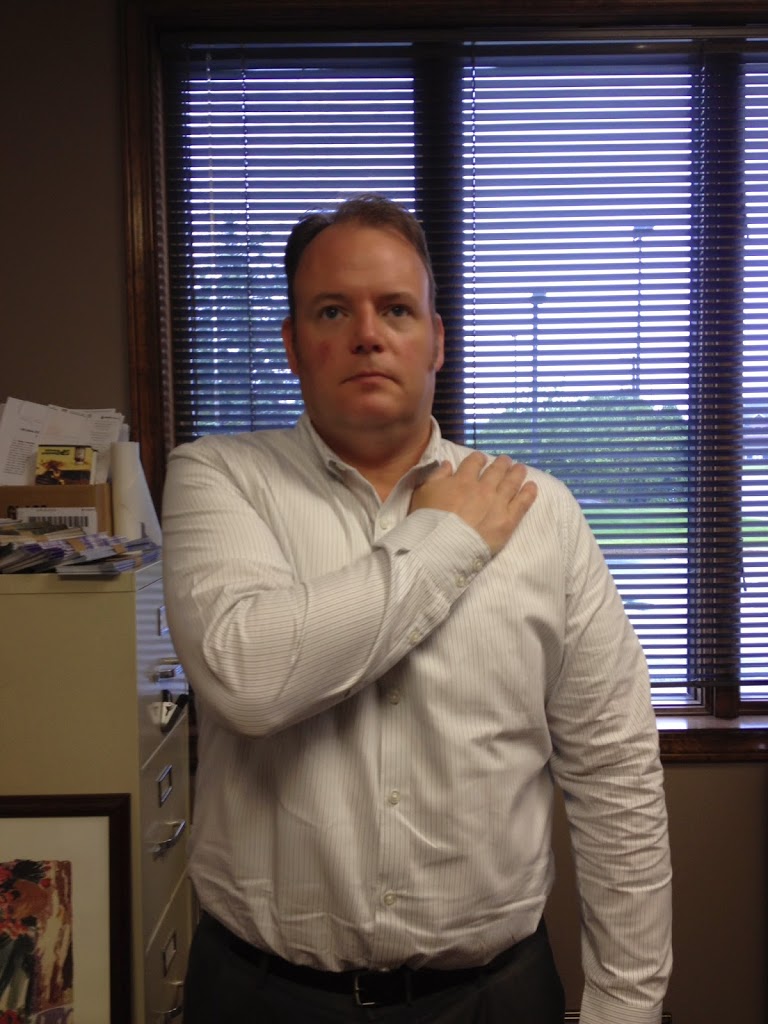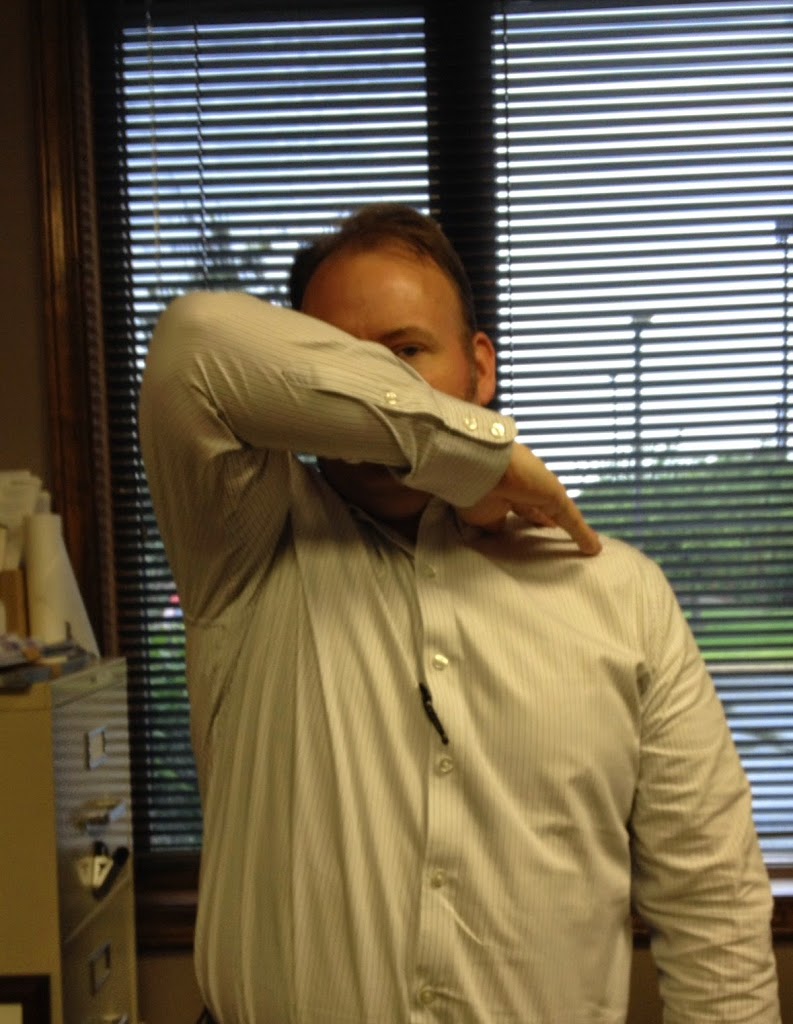Warmer weather is finally here, and that means increased physical activity for most people. We’re barely clear of Winter and already I’ve had some folks with golf and/or landscaping injuries to their shoulders. Some are relatively acute, or new, others have been lingering for days, weeks, or even months. Shoulder conditions can be quite debilitating, regardless of your daily activity level. I thought I would share some background on the most common types of shoulder conditions we see in the office and what we typically do about them, but first, a little about the shoulder itself.
The shoulder is an amazing bit of engineering. It allows the greatest range of motion of any joint in the body. To be technically correct, the shoulder is actually comprised of three(3) joints and an “articulation”: The glenohumeral joint (GH) is the “ball and socket” component, the acromioclavicular joint (AC) is the union between the scapula (shoulder blade) and the clavicle (collar bone), the sternoclavicular joint (SC) is the connection between the collar bone and the sternum (breastbone), and the scapulothoracic “articulation”, which describes the relationship between your shoulder blade and the rib cage on which it rests and moves. All four must move in a synchronized manner for the shoulder to function properly. Because it does allow such a wide range of motion, the shoulder is inherently unstable. Overuse, poor posture, and strain are typical factors in the development of shoulder pain syndromes.
There are many muscles, tendons, and other soft tissues that can be irritated or injured. Pain and limited motion are the reasons most people present for treatment. The most common issues we see are rotator cuff injuries and bursitis.
THE ROTATOR CUFF
The rotator cuff is made of four tendons that attach to the ball portion of the upper arm bone (humerus). The cuff is made up of the tendons of four muscles that originate from the scapula:
- Supraspinatus
- Infraspinatus
- Teres Minor
- Subscapularis
We call these the “SITS” muscles. The function of these muscles is to rotate the upper arm. They can be strained by repetitive movements and/or frequent malposition of the arm from poor posture. Golf and throwing sports (baseball, football, etc) have their fair share of players with rotator cuff injuries because of the tremendous amounts of force and repetitive movements.
Strain involves damage to the muscular portion of the rotator cuff, but the tendons are frequently damaged as well. Sometimes, the tendons can be torn by force, or be worn by repetitive movement that causes it to rub against another structure. On MRI, we sometimes hear of a rotator cuff tendon being “frayed.” Think of a rope being rubbed back and forth across a jagged rock, that’s about what it looks like. In some instances, this tear must be surgically repaired. However, a lot of the time, physical therapy including pain and inflammation control using electric stimulation and ultrasound, coupled with joint mobilization and therapeutic exercise can restore the function of the shoulder without surgery.
BURSITIS
The vast range of motion in the shoulder means that things are going to rub against one another. Luckily, the body has developed a structure to deal with this sort of internal friction: The BURSA. A bursa is simply a fluid filled sack that allows one layer of muscle to slide smoothly over another, or a muscle to glide over a bone. The most commonly affected bursa in the shoulder is the Subdeltoid Bursa, which is underneath the deltoid muscle, which makes up the contour of your shoulder.
Sometimes, this bursa will get pinched between the ball portion of the shoulder joint and the inside of the AC joint, or if there is significant and repetitive movement which utilizes the deltoid, it will become inflamed, or swollen. Bursitis is a general term for when this structure gets inflamed.
Bursitis also responds well to dry needling, electric stimulation, ultrasound, mobilization and exercises. Typically, bursitis goes away more quickly than rotator cuff syndromes, but sometimes these two occur together.
OTHER SHOULDER CONDITIONS
There are other conditions that can affect the shoulder. A labral tear is a disruption of the cartilage that deepens the shoulder socket. Adhesive capsulitis (a.k.a. Frozen shoulder) is a condition in which the tough fibrous covering of the shoulder contracts, often painfully, and restricts motion in most, if not all motions. It is very painful, but does respond well to acupuncture. Arthritis of the shoulder joints typically occurs after injury or years of overuse, and the degenerative changes are often unknown until pain or loss of function occur. Referred pain from conditions affecting internal organs or other processes can also result in shoulder pain.
THE TEST
The following pictures illustrate a simple test that may help you determine if you’ve got a shoulder problem such as bursitis, rotator cuff, or other internal shoulder joint issue:
Starting Position
Finishing Position
A positive test is when you cannot get to the end point without pain. Most people with shoulder problems cannot get to this point, and usually stop moving the shoulder well before the end point.
WHAT DO I DO IF THE TEST HURT?
Let’s be clear: this test is non-specific and doesn’t differentiate between types of shoulder problems. In the office, it’s usually the first shoulder test I do to determine if something is going on within the shoulder itself or if it’s radiating from the neck, upper back, or an internal organ such as the gallbladder (right) or heart (left). So, there are two possibilities:
1. Your shoulder hurts and the test hurt. If this describes your situation, then it is very likely that you have an internal shoulder issue. It does not matter how much your shoulder hurts, if the test hurts, then it would be a good idea to give us a call and get it checked out. There are other tests that can help us determine more accurately what is going on in the shoulder.
2. Your shoulder hurts but the test didn’t make it hurt worse. In this situation, your shoulder may be hurting because of radiating pain from the neck, upper back, or an internal organ such as the heart or gallbladder. If you suspect the heart or gallbladder, you should contact your MD immediately, call 911 or go to the ER. In the absence of pain from the heart or gallbladder, the neck and/or upper back is a possible source for your shoulder pain. Again, we can do tests in our office that will help determine the source of your pain.
TREATMENT
Injury is almost always accompanied by pain and inflammation or swelling. It may not be possible to feel or see the swelling yourself. Our first line of treatment once the cause has been identified is to knock down the pain and inflammation using
electric stimulation and
ultrasound. The electric stimulation decreases pain by interrupting the pain signal sent from the injured tissue to the brain. It also helps reduce any muscle spasm that may be present. Ultrasound uses high frequency sound waves that penetrate deeply to push the swelling out of the injured structure and into the surrounding circulation so that it may be cleaned up by the body.
Acupuncture and Dry Needling are options for shoulder pain. Joint mobilization is typically performed to reset the joint surfaces so the ball and socket can glide properly on one another. We often do chiropractic manipulation to the neck and mid back (thoracic spine) because of the high degree of nervous and muscular interconnection between these areas of the spine and the shoulder. In certain circumstances, we recommend natural anti-inflammatory and soft tissue repair supplements(
Turmeric Forte,
Zymex II and
Ligaplex II from
Standard Process). Once the pain has reached a manageable level and range of motion allows, we start doing therapeutic exercises to increase flexibility (initially) and strength (later). Length of treatment typically depends on the severity of the condition and the compliance of the patient with the treatment schedule and home recommendations.
Whether your pain is from the shoulder, neck or back, we have the skills and experience treating these issues and can help you get back on track to enjoy your summer! Give us a call at 219-738-1925 today!

